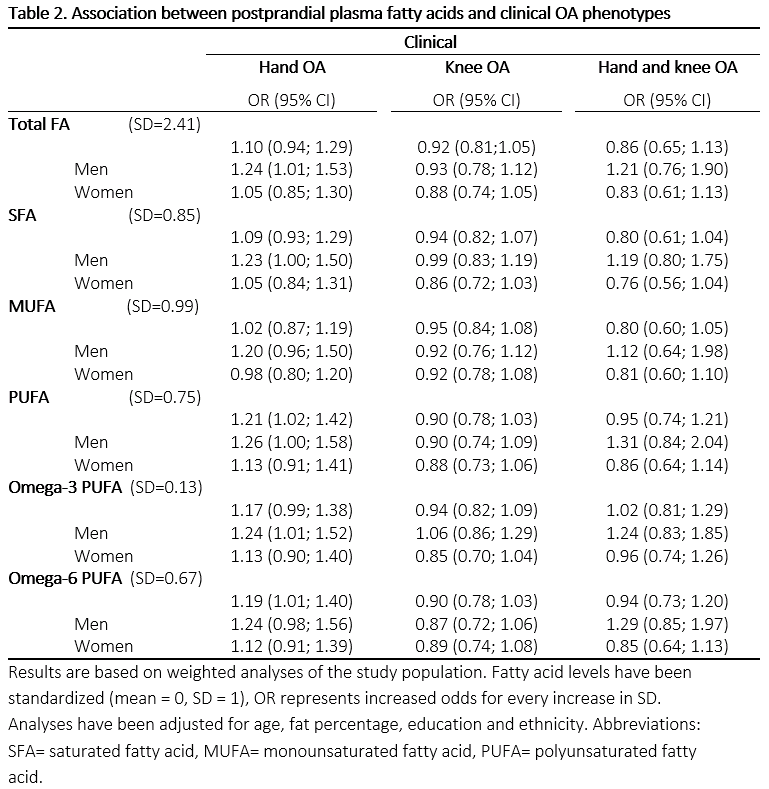Session Information
Session Type: Poster Session (Tuesday)
Session Time: 9:00AM-11:00AM
Background/Purpose: Obesity is one of the most important risk factors for osteoarthritis, and is strongly associated with increased levels of circulating fatty acids, which may result in lipotoxicity. However, our knowledge about the effect of different fatty acids on osteoarthritis is sparse. Therefore we aimed to investigate the association of plasma saturated fatty acids (SFAs), monounsaturated fatty acid (MUFAs), polyunsaturated fatty acids (PUFAs), omega-3 and omega-6 PUFAs with clinically defined hand and knee osteoarthritis.
Methods: In the population-based Netherlands Epidemiology of Obesity study, hand and knee osteoarthritis were defined by the ACR clinical classification criteria. Clinical hand and knee OA were defined by the ACR clinical classification criteria. Hand OA, knee OA and concurrent hand and knee OA were defined in 7%, 10% and 4% of participants, respectively. Plasma was sampled fasted and after a standardized meal (containing 600kCal, with 16% of energy (En%) derived from protein, 50 En% from carbohydrates and 34 En% from fat), and subsequently analysed using a nuclear magnetic resonance metabolomics platform. Since we are in a postprandial state most of the day, the postprandial samples were used for the primary analyses. All fatty acid concentrations were standardized (mean 0, SD 1). We excluded participants who reported to have inflammatory rheumatic disease or fibromyalgia, with missing physical examination, who were non-fasting at baseline, or reported using lipid-lowering medication. Logistic regression analyses were used to investigate the association between total fatty acids, SFAs, MUFAs, PUFAs, omega-6 PUFAs and omega-3 PUFAs and clinical osteoarthritis phenotypes. All analyses were stratified by sex and corrected for age, education, ethnicity and total body fat percentage.
Results: In the current analysis 5,328 NEO participants were included, with a mean age of 56 years and 58% were women (table 1). Unstratified analyses showed positive associations with OR (95% CI) of total PUFA concentrations 1.21 (1.02; 1.42), omega-3 1.17 (0.99; 1.38) and omega-6 PUFA concentrations 1.19 (1.01; 1.40) with clinical hand OA, but not with clinical knee OA. In men, total fatty acids 1.24 (1.01; 1.53), SFA 1.23 (1.00 – 1.50), total PUFA 1.26 (1.00 – 1.58) and omega‑3 PUFA levels 1.24 (1.01 – 1.52) were positively associated with clinical hand OA. Similar effect estimates were observed with concurrent hand and knee OA, but not for clinical knee OA alone. In women no associations were seen of any of the fatty acids with clinical hand or knee OA (table 2).
Conclusion: Quantitively measured plasma postprandial SFA and PUFA levels were significantly associated with hand OA in men. Intriguingly, although SFA and omega-3 PUFAs are deemed to have opposing effects on inflammation, both were positively associated with hand OA. Future research is warranted for replication and to determine whether there is a causal role for plasma fatty acid levels in hand OA.
To cite this abstract in AMA style:
Loef M, Ioan-Facsinay A, Mook-Kanamori D, Willems van Dijk K, de Mutsert R, Kloppenburg M, Rosendaal F. The Association of Plasma Fatty Acids Levels with Hand and Knee Osteoarthritis [abstract]. Arthritis Rheumatol. 2019; 71 (suppl 10). https://acrabstracts.org/abstract/the-association-of-plasma-fatty-acids-levels-with-hand-and-knee-osteoarthritis/. Accessed .« Back to 2019 ACR/ARP Annual Meeting
ACR Meeting Abstracts - https://acrabstracts.org/abstract/the-association-of-plasma-fatty-acids-levels-with-hand-and-knee-osteoarthritis/


